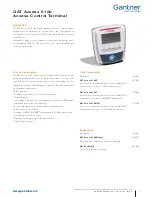
131
SLAS826F – MARCH 2015 – REVISED MARCH 2017
Product Folder Links:
Detailed Description
Copyright © 2015–2017, Texas Instruments Incorporated
Table 6-49. TA3 Signal Connections
DEVICE INPUT PIN OR INTERNAL
SIGNAL
MODULE INPUT
SIGNAL
MODULE
BLOCK
MODULE
OUTPUT SIGNAL
DEVICE OUTPUT PIN OR
INTERNAL SIGNAL
P8.3/TA3CLK/A22
TACLK
Timer
N/A
N/A
ACLK (internal)
ACLK
SMCLK (internal)
SMCLK
From Capacitive Touch I/O 1
(internal)
INCLK
P10.4/TA3.0/C0.7
CCI0A
CCR0
TA0
P10.4/TA3.0/C0.7
TA3_C0 (internal)
DV
SS
CCI0B
DV
SS
GND
DV
CC
V
CC
P10.5/TA3.1/C0.6
CCI1A
CCR1
TA1
P10.5/TA3.1/C0.6
TA3_C1 (internal)
ADC14 (internal)
ADC14SHSx = {7}
ACLK (internal)
CCI1B
DV
SS
GND
DV
CC
V
CC
P8.2/TA3.2/A23
CCI2A
CCR2
TA2
P8.2/TA3.2/A23
TA3_C2 (internal)
C0OUT (internal)
CCI2B
DV
SS
GND
DV
CC
V
CC
P9.2/TA3.3
CCI3A
CCR3
TA3
P9.2/TA3.3
TA3_C3 (internal)
TA2_C3 (internal)
CCI3B
DV
SS
GND
DV
CC
V
CC
P9.3/TA3.4
CCI4A
CCR4
TA4
P9.3/TA3.4
TA3_C4 (internal)
From Capacitive Touch I/O 1
(internal)
CCI4B
DV
SS
GND
DV
CC
V
CC
6.9.4
Timer32
Timer32 is an ARM dual 32-bit timer module. It contains two 32-bit timers, each of which can be
configured as two independent 16-bit timers. The two timers can generate independent events or a
combined event, which can be processed according to application requirements. Timer32 runs out of the
same clock as the Cortex-M4 CPU.
6.9.5
Enhanced Universal Serial Communication Interface (eUSCI)
The eUSCI modules are used for serial data communication. The eUSCI module supports synchronous
communication protocols such as SPI (3-pin or 4-pin) and I
2
C, and asynchronous communication
protocols such as UART, enhanced UART with automatic baud-rate detection, and IrDA.
The eUSCI_An module provides support for SPI (3-pin or 4-pin), UART, enhanced UART, and IrDA.
The eUSCI_Bn module provides support for SPI (3-pin or 4-pin) and I
2
C.
The MSP432P401x MCUs offer up to four eUSCI_A and four eUSCI_B modules.
6.9.6
Real-Time Clock (RTC_C)
The RTC_C module contains an integrated real-time clock. It integrates an internal calendar which
compensates for months with less than 31 days and includes leap year correction. The RTC_C also
supports flexible alarm functions, offset calibration, and temperature compensation. The RTC_C operation
is available in LPM3 and LPM3.5 modes to minimize power consumption.
















































